| Toy
Hong Kong's toy industry was
first established in the 1940's, producing simple
toys with hand-operated machinery. Today’s toy industry
has been well developed and can be divided into four
major categories:
-
Plastic toys, including plastic
dolls and other accessories, toy figures, building
blocks, toy guns and other small toys. More than
two third of Hong Kong's toy factories focus on
plastic toys;
-
Electronic toys, including
radio/remote-control and battery-operated toy
boats and cars, musical and communication toys,
and game machines;
-
Metal toys, including toy
cars and friction-driven designs and robots, dolls
and animals;
-
Wooden toys, which is of limited
variety. The majority of such products are manufactured
upon purchasing orders placed by customers or
on franchised terms.
Hong Kong’s toy manufacturers
are mostly engaged in Original Equipment Manufacturing
(OEM), while more and more of them have begun to sell
self-designed products under their own brand names.
In the recent years, Hong Kong manufacturers have
been actively seeking offshore production facilities
not only in the Chinese mainland but also in other
low production cost countries. There were 297 toy
establishments left in Hong Kong by 1999, hiring 1,956
workers. Although the domestic exports of toys recorded
only HK$626 million, the re-exports reached an impressive
HK$84,943 million in 1998.
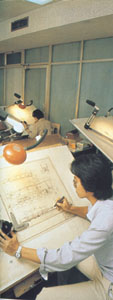 |
|
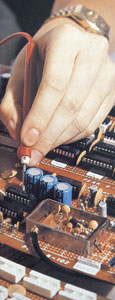 |
| But it all starts at the drawing board
as shown in the photograph where a mechanical
engineer is drawing the fine lines for
a complicated train set. |
|
Deft hands test the circuitry and components
of complicated computer games in a Kowloon factory. |
|
|

The manufacture
of plasticware had been one of Hong Kong's major industries
decades ago, with nearly 300 registered factories
and a labour force estimated at over 8,000 by the
end of 1958. In the picture is one of the designers'
studios.
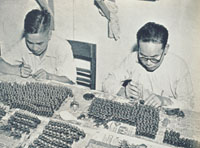
These toy
soldiers were made in unbreakable plastic and were
remarkable for the fine details of their design.
They were hand painted.
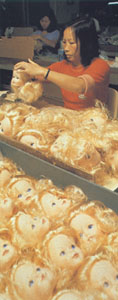
Traditional toys never die and one of the
most popular items is still the stuffed doll, each
with its hair neatly combed before final assembly.
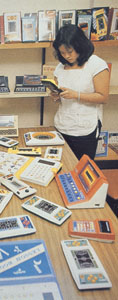
Brain-testing computer based games and educational
aids by the score are checked in a manufacturer's
display room.
|



